Bryophyte, traditional name for any non-vascular seedless plant. They are the nearest existing relative of early terrestrial plants. They can be found in all ecosystems of earth. Bryophytes are an unceremonious group consisting of three divisions the liverworts, hornworts and mosses .
Here we will discuss about Sphaerocarpales, which is known as ” bottle liverworts” . There are 8 or 9 species in this genus . When they are distributed, it looks like a green sea anemone.
The class of the liverworts is ” Hepaticopsida” .Get Free Netflix Now
Best safe and secure cloud storage with password protection
Get Envato Elements, Prime Video, Hotstar and Netflix For Free
Best Money Earning Website 100$ Day
#1 Top ranking article submission website
Hepaticopsida
- Divided into four orders
- Sphaerocarpales
- Marchantiales
- Jaungermanniales
- Calobryales.
Sphaerocarpales
- Gametophyte leafy and consists of an axis bearing two rows of alternately inserted lobes of “leaves”.
- Development and structure of sex organs as well as structure of sporophyte similar to those of Marchantiales.
- Chief diagnostic feature is the presence of a globose or flask-shaped envelope (involucre)around each of the sex organ.
Two families:
- Sphaerocarpaceae with two genera Sphaerocarpos and Geothallus.
- Riellaceae with single genus Riella.
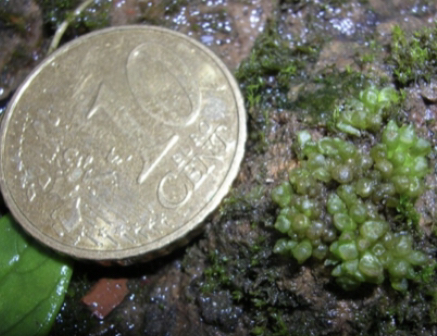
Distribution and Habitat
- Approximately 20 species are in this genus. They are terrestrial.
- Spaherocarpos is not common in subcontinent rather it shows luxuriant growth in U.S.A, chiefly in the Gulf and Pacific coast.
- Mostly grown on moist, shady and colder places. The morphological characters of the thallus vary if habitat is changed.
General Characteristics
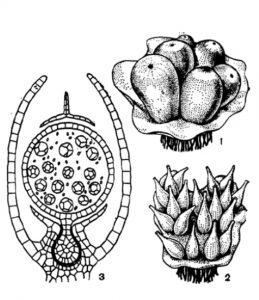
- The plant body is thalloid but sometimes it shows a tendency toward the development of leaves on the dorsal surface of axis(midrib).
- Ventral scales are absent but mucilaginous hairs are found near growing points.
- The tuberculate rhizoids are absent, only smooth-walled rhizoids are present.
- In vertical transverse section the thallus shows neither photosynthetic zone nor storage zone.
- All the cells are uniformly green in thallus.
- Photosynthetic chambers, air pores and filaments are not found.
- Each antheridium or archegonium is enclosed with in a special covering known as involucre or bottle.
- The sporophyte has small foot, very small seta and a globose capsule.
- The capsule wall is one cell-layer thick, no thickening bands.
- The elaters are absent.
- The nurse cells are present within capsule along with developing spores, which provides nourishment.
- The dehiscence of capsule is irregular.
External features of Gametophyte
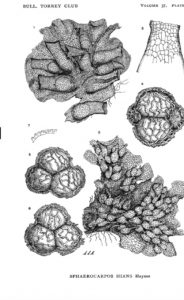
- The gametophytic plant body is thalloid.
- The thallus is prostrate, dorsiventrally flattened, dichotomously branched and dark green in color.
- Most of the species have notched margin and each notch bear a growing point.
- In some species the margin of the thallus is entire and smooth.
- In some other species have very prominent midrib which looks like an axis.
- It bears succubously arranged and dorsally appressed leaf like lobes.
- The dorsal surface of the thallus is smooth.
Anatomy of the thallus
- It has very simple anatomy.
- The thallus has neither photosynthetic zone nor storage zone.
- The photosynthetic chambers, photosynthetic filament and air pores are also absent.
- All the cells possess chloroplasts except the rhizoidal cells.
Reproduction
Sphaerocarpos reproduces vegetatively and very well by sexual process which is controlled by sex chromosomes-also named as “X” and “Y” chromosomes.
Vegetative Reproduction
- Adventitious branches
- Dichotomous branches
Sexual Reproduction
All the species of the genus are dioecious. Both male and female plants are separate and differ from each other in external morphology which is controlled genotypically by sex chromosomes.
Male Plant

- The male plants are relatively smaller in size than female plants.
- The dorsal surface of the thallus has several flask-shaped sessile involcures which open outside by a mouth.
- The involucre is one cell layer thick and formed by elevation of dorsal surface.
- Each involucre has a single antheridium.
- The body of which is large and globose and situated on short stalk.
- The body of antheridium has a single cell layer thick sterile covering, the cells of which contain chromatophores providing deep orange-red color to the mature antheridium.
- Inside the sterile covering there is present biflagellated spindle-shaped or coiled antherozoids. Out of two flagella, the lower is slightly longer.
- The development of antheridium is same as found in order marchantiales.
Female Plant
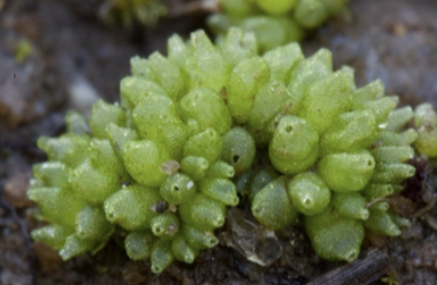
- The female plants are larger than male plants.
- The dorsal surface of female plant bears numerous oval involucres with a wide mouth as its top.
- The involucres of female plants are also one cell layer thick and all the cells contain chloroplasts.
- Each oval-shaped involucre loosely covers a single archegonium. Each archegonium is sessile and short.
- The neck of the archegonium has six vertical rows of cells that enclose an axial row of only four neck canal cells.
- The venter of archegonium contains a venter canal cell and a large egg.
- The development of archegonium is also Marchantiales type.
Fertilization
- The process of fertilization is similar to that found in the plants of the order Marchantiales.
- The water is necessary for fertilization.
- The antherozoids reach to the mouth of the neck of archegonium through water.
- The water is also essential for separation of cover cells.
- A film of water is found in the dorsal furrow of the thallus. This film acts as capillary tube.
- Mucilaginous substances along with proteins and certain inorganic salts ooze out through the mouth of the archegonium.
- The antherozoids are attracted chemotactically by this protein and inorganic salts.
- The antherozoids enter the mouth of the archegonium. They travel through the neck and reach near the egg. One of the antherozoids penetrates egg cell and the fertilization takes place.
Sporophyte
- After fertilization, the zygote divides by mitosis and forms two daughter cells- the upper cell is called as epibasal cell and the lower cell is known as hypobasal cell.
- Both epibasal and hypobasal cells are diploid and again divide by transverse division and form four celled uniseriate filamenys pro-embyo.
- Now each of pro-embro divides by two longitudinal divisions at right angles each other.
- Thus a sixteen celled embryo is produced in which eight cells are arranged in two tires in the epibasal part and the remaining eight cells are arranged in the hypobasal part. The former (epibasal) forms the capsule and the later (Hypobasal) forms small foot and very small seta.
- Foot: It is small, slightly bulbous. Its function is absorption of food from thallus and to fix the sporophyte within the female involucre.
- Seta: It is very small and middle part of the sporophyte. The seta never elongates and always remains only few cells in height.
- Capsule: The upper most spherical or globose part the sporophyte is called capsule. It is one celi layer thick capsule wall which is derived from amphithecium. The cells of capsule wall contain chloroplasts. The caviity of capsule is filled by spores and nurse cells which are produced from endothecium. It is interesting to note that the nurse cells of Sphaerocarpos contain chloroplasts.
Sporophyte Characteristics
- Foot, seta and capsule are present.
- Foot is small and bulbous.
- The capsule is globose.
- Capsule wall is one layered.
- Amphithecium forms the jacket of the capsule.
- Endothecium forms the archesporium.
- Archesporium gives rise to the spores and nurse cells.
- Sporophyte is partial autotrophic nature due to presence of choloroplasts in the capsule wall and nurse cells.
Spores and germination of spores
Sphaerocarpos is of particular interest because in it sex chromosomes were first observed in plants. Like garden peas, it has been seven pairs of autosomic chromosomes, but in addition the sporophyte has a pair of sex chromosomes(XY). At the time of meiosis the spore mother cell forms a tetrad spores. Two spores of a tetrad germinate and form two large thalli of female plants. The haploid number of chromosomes in each cell of the gametophytic plant body as eight (n=8). In male plant each cell has seven autosomes of normal size and one chromosomes is small and known as sex chromosomes and designated as “Y” chromosomes.
Like male plant body female plant has seven autosomes and one chromosomes is considerably large and is known as “X” chromosomes.
 Plantlet The Blogging Platform of Department of Botany, University of Dhaka
Plantlet The Blogging Platform of Department of Botany, University of Dhaka


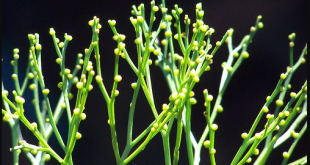
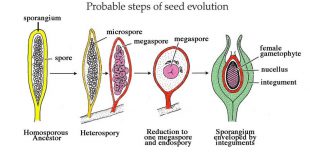
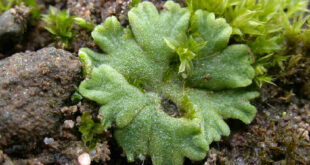
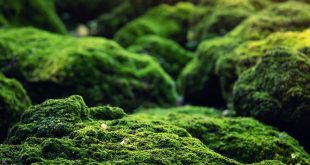
Your point of view caught my eye and was very interesting. Thanks. I have a question for you.
I enjoy this article fery much. Thx for making this article, it realy make my day